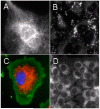Squaraine rotaxanes: superior substitutes for Cy-5 in molecular probes for near-infrared fluorescence cell imaging
- PMID: 17585399
- PMCID: PMC2854038
- DOI: 10.1002/anie.200701491
Squaraine rotaxanes: superior substitutes for Cy-5 in molecular probes for near-infrared fluorescence cell imaging
Figures



References
-
- Amato I. Chem. Eng. News. 2006 Sept 4;:49.
- Betzig E, Patterson GH, Sougrat R, Lindwasser OW, Olenych S, Bonifacino JS, Davidson MW, Lippincott-Schwartz J, Hess HF. Science. 2006;313:1642–1645. - PubMed
- Rust MJ, Bates M, Zhuang X. Nat. Methods. 2006;3:793–795. - PMC - PubMed
- Willig KI, Rizzoli SO, Westphal V, Jahn R, Hell SW. Nature. 2006;440:935–939. - PubMed
-
- Sapsford KE, Berti L, Medintz IL. Angew. Chem. Intl. Ed. 2006;45:4562–4588. - PubMed
- Wang F, Tan WB, Zhang Y, Fan X, Wang M. Nanotechnology. 2006;17:R1–R13.
-
- Giepmans BN, Adams SR, Ellisman MH, Tsien R. Science. 2006;312:217–224. - PubMed
-
- Licha K. Topics in Curr. Chem. 2002;222:1–29.
Publication types
MeSH terms
Substances
Grants and funding
LinkOut - more resources
Full Text Sources
Other Literature Sources

